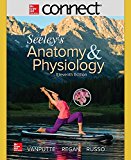
Connect with LearnSmart Labs Access Card for Seeley's A&P
11th Edition
ISBN: 9781259807657
Author: Cinnamon VanPutte, Jennifer Regan, Andrew F. Russo Dr., Rod R. Seeley Dr.
Publisher: MCGRAW-HILL HIGHER EDUCATION
expand_more
expand_more
format_list_bulleted
Concept explainers
Question
Chapter 2.4, Problem 41AYP
Summary Introduction
To describe:
The six roles of lipids in the body with example.
Introduction:
Lipids come into the category of a major group of organic molecules. Lipids are relatively insoluble in water. They are primarily made up of carbon, hydrogen, and oxygen. They are less polar and can easily dissolve in nonpolar organic solvents.
Expert Solution & Answer
Want to see the full answer?
Check out a sample textbook solution
Students have asked these similar questions
State six roles of lipids in the body, and give an exampleof each.
Describe the structures, functions, properties and types of lipids (e.g. fats, phospholipids, steroids). Recognize examples of the different types of lipids.
List the classes of lipids and provide a function for each.
Chapter 2 Solutions
Connect with LearnSmart Labs Access Card for Seeley's A&P
Ch. 2.1 - Define matter. How are the mass and the weight of...Ch. 2.1 - Differentiate between element and atom. What four...Ch. 2.1 - Prob. 3AYPCh. 2.1 - Which subatomic particle determines the atomic...Ch. 2.1 - What is an isotope? How are isotopes denoted?Ch. 2.1 - What is avogardro’s number? How is it related to a...Ch. 2.1 - Describe how an ionic bond is formed. What are...Ch. 2.1 - What occurs in the formation of a covalent bond?...Ch. 2.1 - Distinguish between a molecule and a compund. Give...Ch. 2.1 - What are intermolecular forces, and how do they...
Ch. 2.1 - What is meant by the statement “table sugar is...Ch. 2.1 - Describe what occurs during the dissociation of...Ch. 2.1 - Explain the difference between electrolytes and...Ch. 2.2 - Using the terms reactant and product, describe...Ch. 2.2 - Contrast synthesis and decomposition reactions,...Ch. 2.2 - Describe the role of water in dehydration and...Ch. 2.2 - What is a reversible reaction? How does this type...Ch. 2.2 - What are oxidation-reduction reactions?Ch. 2.2 - Define energy. How are potential and kinetic...Ch. 2.2 - Summarize the characteristics of mechanical,...Ch. 2.2 - Use ATP and ADP to Illustrate the release or input...Ch. 2.2 - Define activation energy, catalyst, and enzymes;...Ch. 2.2 - What effect does increasing temperature or...Ch. 2.3 - What is the difference between inorganic and...Ch. 2.3 - What two properites of water are the result of...Ch. 2.3 - List and briefly describe the four functions that...Ch. 2.3 - Prob. 27AYPCh. 2.3 - Prob. 28AYPCh. 2.3 - Prob. 29AYPCh. 2.3 - Prob. 30AYPCh. 2.3 - Prob. 31AYPCh. 2.3 - Prob. 32AYPCh. 2.3 - Prob. 33AYPCh. 2.3 - Prob. 34AYPCh. 2.3 - What are the functions of oxygen and carbon...Ch. 2.4 - Prob. 36AYPCh. 2.4 - Prob. 37AYPCh. 2.4 - Prob. 38AYPCh. 2.4 - Prob. 39AYPCh. 2.4 - Which carbohydrates are used for energy? What is...Ch. 2.4 - Prob. 41AYPCh. 2.4 - Prob. 42AYPCh. 2.4 - Prob. 43AYPCh. 2.4 - Prob. 44AYPCh. 2.4 - Prob. 45AYPCh. 2.4 - Prob. 46AYPCh. 2.4 - What are the building blocks of proteins? What...Ch. 2.4 - Prob. 48AYPCh. 2.4 - Prob. 49AYPCh. 2.4 - Compare the lock-and-key and the induced fit...Ch. 2.4 - Prob. 51AYPCh. 2.4 - What are the basic building blocks of nucleic...Ch. 2.4 - DNA is like a twisted ladder. What forms the sides...Ch. 2.4 - Prob. 54AYPCh. 2.4 - Prob. 55AYPCh. 2.4 - Prob. 56AYPCh. 2.4 - Prob. 57AYPCh. 2 - Prob. 1RACCh. 2 - Prob. 2RACCh. 2 - Prob. 3RACCh. 2 - Prob. 4RACCh. 2 - Table salt (NaCl) is an atom organic. a molecule....Ch. 2 - Prob. 6RACCh. 2 - Prob. 7RACCh. 2 - Prob. 8RACCh. 2 - Prob. 9RACCh. 2 - Prob. 10RACCh. 2 - Prob. 11RACCh. 2 - Which of these statements concerning enzymes is...Ch. 2 - Prob. 13RACCh. 2 - Prob. 14RACCh. 2 - Prob. 15RACCh. 2 - Prob. 16RACCh. 2 - A buffer slows down chemical reactions. speeds up...Ch. 2 - Prob. 18RACCh. 2 - Prob. 19RACCh. 2 - Prob. 20RACCh. 2 - Prob. 21RACCh. 2 - Prob. 22RACCh. 2 - Prob. 23RACCh. 2 - DNA molecules conatin genes. contain a single...Ch. 2 - Prob. 25RACCh. 2 - Prob. 1CTCh. 2 - Prob. 2CTCh. 2 - A mixture of chemicals is warmed slightly. As a...Ch. 2 - Two solutions, when mixed together at room...Ch. 2 - Prob. 5CTCh. 2 - Prob. 6CTCh. 2 - Carbon dioxide that accumulates in the blood can...Ch. 2 - An enzyme (E) catalyzes the following reaction:...Ch. 2 - Using the materials commonly found in a kitchen,...
Knowledge Booster
Learn more about
Need a deep-dive on the concept behind this application? Look no further. Learn more about this topic, biology and related others by exploring similar questions and additional content below.Similar questions
- Describe the general characteristics of lipids, and list the three main kinds of lipids.arrow_forwardDescribe the relationship between unsaturated and saturated lipids and their physical properties.arrow_forwardName and describe the four different categories of lipids including their structures and functions; be sure to discuss both saturated and unsaturated fatty acidsarrow_forward
- Describe the relationship between the degree of unsaturation and the physical characteristics of lipids. Draw a triacylglycerol containing three units of 18:3 (9,12,15). Describe five major types of lipids.arrow_forwardList several functions of lipids in living organism. What kind of organic compound involved in fat formation contains carboxyl group.arrow_forwardDescribe the molecular structures of the three main types of lipids.arrow_forward
arrow_back_ios
SEE MORE QUESTIONS
arrow_forward_ios
Recommended textbooks for you

Macromolecules | Classes and Functions; Author: 2 Minute Classroom;https://www.youtube.com/watch?v=V5hhrDFo8Vk;License: Standard youtube license